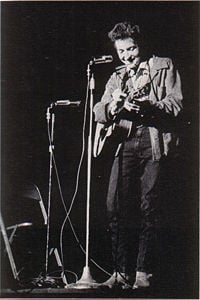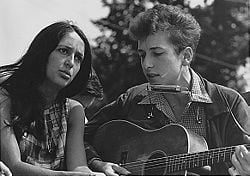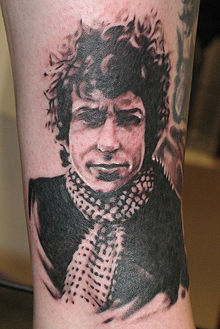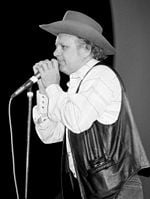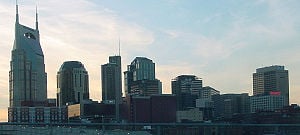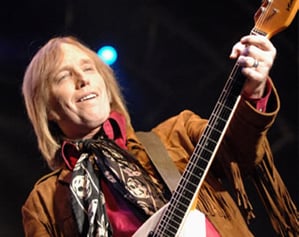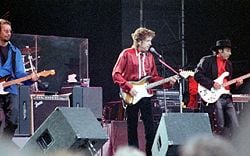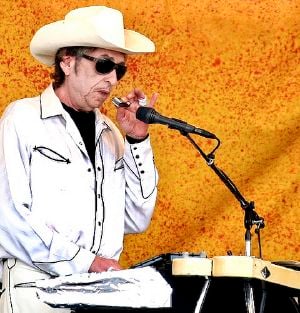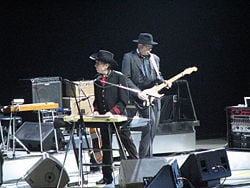Bob Dylan
| Bob Dylan | |
|---|---|
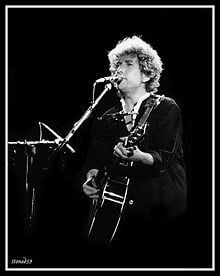 Dylan in Barcelona, Spain in 1984
| |
| Background information | |
| Birth name | Robert Allen Zimmerman |
| Also known as | Blind Boy Grunt, Lucky Wilbury/Boo Wilbury, Sergei Petrov, Jack Frost, Jack Fate, Willow Scarlet, Robert Milkwood Thomas. |
| Born | May 24 1941 (age 82) Duluth, Minnesota, U.S. |
| Genre(s) | Folk, rock, blues, country |
| Occupation(s) | Singer-songwriter, author, poet, artist, actor, screenwriter, disc jockey |
| Instrument(s) | Vocals, guitar, bass guitar, harmonica, keyboards |
| Years active | 1959–present |
| Label(s) | Columbia, Asylum |
| Associated acts | The Band, Rolling Thunder Revue, Traveling Wilburys, Joan Baez, others |
| Website | www.bobdylan.com |
Bob Dylan (born Robert Allen Zimmerman) (May 24, 1941 - ) is an American singer-songwriter, author, musician, poet, and disc jockey who has been a major figure in U.S. culture for more than half a century.
Much of Dylan's most celebrated work dates from the 1960s, when he became an informal chronicler and a reluctant figurehead of American unrest. A number of his songs, such as "Blowin' in the Wind" and "The Times They Are a-Changin'" became anthems of the anti-war and civil rights movements, although Dylan himself declined to remain actively involved in political affairs.
His later work has shown steadfast devotion to many traditions of American song, from folk and country/blues to gospel, rock and roll, and rockabilly, to English, Scottish, and Irish folk music, even jazz and swing. Dylan performs with the guitar, keyboard, and harmonica. Backed by a changing lineup of musicians, he has toured steadily since the late 1980s on what has been dubbed the "Never Ending Tour."
Although his accomplishments as performer and recording artist have been central to his career, his songwriting is generally regarded as his greatest contribution. Compositions such as "Like a Rolling Stone," "Mr. Tambourine Man," "You've Got To Serve Somebody," and many others earned him the reputation as the most influential singer-songwriter of the twentieth century. When Dylan informed Grateful Dead lyricist Robert Hunter that he had taken two of his unpublished songs to record in the early 1990s, friends of Hunter's were aghast. Unfazed, Hunter responded by saying, "Bob Dylan doesn't have to ask, man!" Dylan was awarded the Nobel Prize in Literature in 2016 "for having created new poetic expressions within the great American song tradition."
Life and career
Origins and musical beginnings
Robert Allen Zimmerman was born on May 24, 1941, in Duluth, Minnesota, and raised there and in nearby Hibbing, Minnesota, west of Lake Superior. His parents, Abram Zimmerman and Beatrice "Beatty" Stone, were part of the area's small but close-knit Jewish community.
Zimmerman spent much of his youth listening to the radio—first to the powerful blues and country stations broadcasting from Shreveport, Louisiana, and, later, to early rock and roll. He formed several bands in high school, and in his 1959 school year book, Zimmerman listed as his ambition as "To join Little Richard."
Zimmerman enrolled at the University of Minnesota in September 1959. There, his early focus on rock and roll gave way to an interest in American folk music. He soon became actively involved in the Dinkytown folk-music circuit in Minneapolis, fraternizing with local folk enthusiasts and introducing himself on stage as "Bob Dylan."
Move to New York and record deal
Dylan dropped out of college at the end of his freshman year. In January 1961, he moved to New York City. There, he visited his ailing musical idol Woody Guthrie and met Guthrie's old traveling friend Ramblin' Jack Elliott, as well as many other musicians involved in the New York folk-music scene.
From April to September 1961, Dylan played at various clubs around Greenwich Village, gaining recognition after a positive review of a show he played at Gerde's Folk City by critic Robert Shelton in the New York Times. Later that year, Dylan came to the attention of producer John Hammond, signed him to Columbia in October.
Dylan's first album Bob Dylan (1962), consisted of familiar folk, blues, and gospel material combined with two of his own songs. This album made little impact, selling only 5,000 copies in its first year. In August 1962, Dylan officially changed his name to Robert Dylan and signed a management contract with Albert Grossman, who remained Dylan's manager until 1970. By the time that Dylan's second album, The Freewheelin' Bob Dylan, was released in May 1963, he had already won considerable fame as a songwriter. His most famous song of the time, "Blowin' in the Wind," was widely recorded and became an international hit for Peter, Paul, and Mary.
The Freewheelin album made Dylan a household name among folk-music fans. It also marked him as the nation's leading writer of "protest songs." In addition to "Blowin' in the Wind" and the apocalyptic "Hard Rain's Gonna Fall," the album contained love ballads such as "Don't Think Twice It's All Right" and several blues numbers, humorous songs, and self-reflective compositions. Freewheelin presented Dylan as a singer accompanying himself on acoustic guitar or a low-key backing band.
Dylan soon emerged as a dominant figure of the folk music movement centered in Greenwich Village. Although his singing voice was untrained and had an unusual edge, it possessed a unique expressiveness that gave his songs a uniquely poignant and urgent quality. However, his most famous early songs first reached the public through other performers' versions that were more immediately palatable.
Protest and Another Side
Joan Baez became Dylan's particular advocate, as well as his lover, inviting him on stage during her own concerts and recording several of his early songs. By 1963, Dylan and Baez were both prominent in the civil-rights movement, singing together at rallies, including the March on Washington where Martin Luther King, Jr. gave his "I have a dream" speech.
Dylan's next album, The Times They Are a-Changin', solidified his reputation as a protest writer with its title song, which expressed the spirit of what seemed to be an inexorable political and generational shift. The album also addressed topical issues such as the murder of civil rights worker Medgar Evers, love songs like "Boots of Spanish Leather" and "One Too Many Mornings," and messianic "When the Ship Comes In." Dylan also provided a harbinger of things to come in the renunciatory "Restless Farewell," signaling a shift in Dylan's mood toward the cynical.
By the end of 1963, Dylan felt both manipulated and constrained by the folk and protest movements, especially the latter, which looked to him as its poet laureate and prophet. His next album, Another Side of Bob Dylan, had a much lighter mood than its predecessor. Its most famous composition, "It Ain't Me Babe," seemed on its surface to be a song about spurned love, but was later seen as a thinly disguised rejection of the prophetic role his reputation had thrust at him. His new direction was further signaled by the impressionistic "Chimes of Freedom," which sets elements of social commentary against a denser metaphorical landscape, and "My Back Pages," which brutally attacks the simplistic seriousness of his own earlier topical songs.
Going electric
During 1964 and 1965, Dylan’s physical appearance changed rapidly as he moved from the folk scene to a more rock-oriented style and his scruffy jeans and work shirts were replaced by a Carnaby Street wardrobe. His March 1965 album, Bringing It All Back Home, featured his first recordings made with electric instruments. Its first single, "Subterranean Homesick Blues," owed much to Chuck Berry's "Too Much Monkey Business" and was later provided with an early music video courtesy of D. A. Pennebaker's cinéma vérité chronicle of Dylan's 1965 tour of England, Don't Look Back. In 1969, the militant Weatherman group took its name from a line from the song: "You don't need a weatherman to know which way the wind blows."
The album included four lengthy acoustic songs illuminated with the semi-mystical imagery that became another Dylan trademark. "Mr. Tambourine Man" would become one of his best known songs and had already been a number one hit for The Byrds. "Gates of Eden," "It's All Over Now Baby Blue," and "It's Alright Ma (I'm Only Bleeding)" became fixtures in Dylan's live performances for most of his career.
Dylan's successful tour in England took place in the spring of 1965. However, that summer he created a major controversy with his first public electric set, backed by a pickup group drawn mostly from the Paul Butterfield Blues Band, while headlining at the Newport Folk Festival. Dylan met with a mix of cheering and booing and left the stage after only three songs. The boos reportedly came from outraged folk fans who felt Dylan had betrayed the idiom and sold out to commercialism. Dylan soon reemerged and sang two much better received solo acoustic numbers, "Mr. Tambourine Man," and "It's All Over Now, Baby Blue," the latter thought by some to have been an intentional signal to his audience to let go and move on.
The Newport performance provoked an outraged response from the folk music establishment, but on July 29, Dylan was back in the studio in New York to record the hit single "Positively 4th Street." The song, which would be released as a follow-up to the huge success of "Like a Rolling Stone," teemed with images of resentment and revenge and was widely interpreted as a put-down of his estranged friends and fans from the folk community.
Highway 61 Revisited and Blonde on Blonde
In July 1965, Dylan released his most successful single, "Like a Rolling Stone," which peaked at number two in the U.S. and at number four in the UK charts. At over six minutes in length, this song has been widely credited with altering attitudes about both the content and form of the pop single. The song began an anthem of the hippie generation, and in 2004, Rolling Stone magazine listed it at number one on its list of the 500 greatest songs of all time.
The sound of "Like a Rolling Stone" also characterized Dylan's next album, Highway 61 Revisited, featuring surreal litanies of the grotesque, flavored by Mike Bloomfield's blues guitar and Dylan's obvious and sometimes gleeful enjoyment of the sessions. Its closing song, "Desolation Row," is an apocalyptic vision with references to many figures of Western culture.
In support of the record, Dylan was booked for two U.S. concerts and set about assembling a band. Mike Bloomfield was unwilling to leave the Butterfield Band, and neither Al Kooper nor Harvey Brooks from his studio crew wanted to tour with Dylan, and he eventually hired Robbie Robertson and Levon Helm's band, The Hawks, as his tour group. While Dylan and the Hawks met increasingly receptive audiences on tour, their studio efforts floundered. Producer Bob Johnston had been trying to persuade Dylan to record in Nashville for some time, and in February 1966, Dylan, together with Robertson and Kooper, recorded the Nashville sessions which produced the album Blonde on Blonde (1966). For many critics, Dylan's mid-'60s trilogy of albums—Bringing It All Back Home, Highway 61 Revisited, and Blonde on Blonde—represents one of the great cultural achievements of the twentieth century.
On November 22, 1965, Dylan married Sara Lownds. He undertook a tour of Australia and Europe in the spring of 1966. Each show was split into two parts. Dylan performed solo during the first half, accompanying himself on acoustic guitar and harmonica. In the second half, backed by the Hawks, he played high voltage electric music, sometimes to boos and jeers from some sections of the crowd.
The Woodstock years
After his European tour, Dylan returned to New York, but the pressures on him—political, psychological, and professional—continued to increase. ABC Television had paid an advance for a TV show, and his publisher, Macmillan, was demanding a finished manuscript of the poem/novel Tarantula. Meanwhile, manager Albert Grossman had already scheduled an extensive concert tour for that summer and fall.
On July 29, 1966, while Dylan rode his Triumph 500 motorcycle near his home in Woodstock, New York, when its brakes locked and the crash reportedly broke several vertebrae in his neck and resulted in a period of virtual seclusion from the public. In 1967, he began recording music with the Hawks at his home and in the basement of the Hawks' nearby house, known as "Big Pink."
The relaxed atmosphere yielded renditions of many of Dylan's favored old and new songs and some newly written pieces. These songs, initially compiled as demos for other artists to record, provided hit singles for Julie Driscoll ("This Wheel's on Fire"), The Byrds ("You Ain't Goin' Nowhere"), and Manfred Mann ("Quinn the Eskimo (The Mighty Quinn)"). When the the Hawks re-named themselves The Band in 1967, their own recording of Music from Big Pink would begin a long and successful career for them. Columbia belatedly released selections from these recordings in 1975, as The Basement Tapes, and over the years, more and more of these recording appeared, culminating in a five-CD bootleg set titled The Genuine Basement Tapes, containing 107 songs and alternate takes.
In October and November 1967, Dylan returned to Nashville to record what ultimately became the John Wesley Harding album. He was accompanied only by Nashville musicians Charlie McCoy on bass, Kenny Buttrey on drums, and Pete Drake on steel guitar. In his first album since the motorcycle crash Dylan presented a contemplative record of shorter songs, set in a landscape that drew on both the American West and the Bible. The sparse structure and instrumentation marked a departure not only from Dylan's own work but from the escalating psychedelic fervor of the 1960s musical culture. It included the expectant "All Along the Watchtower," with lyrics derived from the Book of Isaiah (21:5–9). The song was later recorded by Jimi Hendrix, whose celebrated version Dylan himself acknowledged as definitive.
When Woody Guthrie died on October 3, 1967, Dylan made his first live appearance in 20 months at a Guthrie memorial concert held at Carnegie Hall on January 20, 1968.
Nashville Skyline
Dylan's next release, Nashville Skyline (1969), featured more instrumental backing by Nashville musicians, including a prominently featured Pete Drake on steel guitar, and a new, uncharacteristically mellow-voiced Dylan. The album also included a duet with Johnny Cash and the hit single "Lay Lady Lay," which reached number five on the U.S. pop charts.
In the early 1970s, critics charged that Dylan's output was of varied and unpredictable quality. Self Portrait, a double LP including only a few original songs, was poorly received. Later that year, Dylan released the New Morning LP, which some considered a return to form. It reached number seven in the U.S. and gave Bob Dylan his sixth UK number one album. A single from this album, "If Not for You," reached number 25 on the U.S. pop charts and spent three weeks at number one on Billboard's Adult Contemporary chart. The album also signaled things to come spiritually with the devotional song "Father of Night."
In March 1971, Dylan recorded "Watching The River Flow" and a new recording of "When I Paint My Masterpiece." However, the only LP released by Dylan in either 1971 or 1972 was Bob Dylan's Greatest Hits Vol. II, which included a number of re-workings of as-then unreleased Basement Tapes tracks, such as "I Shall Be Released" and "You Ain't Goin' Nowhere."
In 1972, Dylan signed onto Sam Peckinpah's film Pat Garrett and Billy the Kid, providing the songs and taking a role as "Alias," a minor member of Billy's gang. Despite the film's failure at the box office, the song "Knockin' on Heaven's Door" has proven to be one of Dylan's most durable compositions, having been covered by over 150 recording artists.
Return to performing
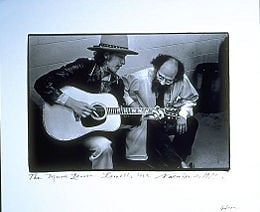
In 1973, Dylan signed with David Geffen's Asylum label after his contract with Columbia Records expired. He recorded Planet Waves with The Band. The album included two versions of one of Dylan's best known songs, "Forever Young," written for one of his children.
In January 1974, Dylan and The Band embarked on a high-profile, coast-to-coast tour of North America. Promoter Bill Graham claimed he received more ticket purchase requests than for any prior tour by any artist. A live double album of the tour, Before the Flood, was released on Asylum.
After the tour, Dylan and his wife became publicly estranged. He soon returned to Columbia Records, and in early 1975, Blood on the Tracks was released. It received mixed reviews at the time but is now seen as one of Dylan's better achievements. The single, "Tangled Up in Blue" peaked at number 31 on the U.S. singles chart.
That summer Dylan wrote his first successful "protest" song in 12 years, championing the cause of boxer Rubin "Hurricane" Carter, whom he believed had been wrongfully imprisoned for a triple murder in Paterson, New Jersey. Despite its 8:32 minute length, the song was released as a single, peaking at number 33 on the U.S. Billboard Chart.
In the fall of 1975, Dylan launched Rolling Thunder Revue tour, featuring many performers, drawn mostly from the resurgent Greenwich Village folk scene, including T-Bone Burnett, Allen Ginsberg, Ramblin' Jack Elliott, Joni Mitchell, Roger McGuinn, and Joan Baez. This marked Baez and Dylan's first joint performances in more than a decade. The tour encompassed the release of the album Desire (1976), with many of Dylan's new songs. Part of the tour was documented by a TV concert special, Hard Rain, and the LP of the same name. An album from the first half of the tour would be released in 2002.
In November 1976, Dylan appeared at The Band's "farewell" concert, along with other guests including Muddy Waters, Eric Clapton, Van Morrison, and Neil Young. Martin Scorsese's acclaimed cinematic chronicle of this show, The Last Waltz, was released in 1978 and included about half of Dylan's set.
Dylan's 1978 album, Street Legal, was lyrically one of his more complex and cohesive. It suffered, however, from a poor sound mix until its remastered CD release nearly a quarter century later.
Born again
In the late 1970s, Dylan became a born-again Christian. He soon released two albums, many with Christian themes music. Slow Train Coming (1979) is generally regarded as the best of these albums, winning him the Grammy Award as "Best Male Vocalist" for the song "Gotta Serve Somebody." Saved (1980), received mixed reviews, although some critics consider it the better of the two Christian albums. When touring from the fall of 1979 through the spring of 1980, Dylan refrained from playing any of his older works, and he delivered declarations of his faith from the stage.
Dylan's embrace of Christianity was extremely unpopular with many of his fans and fellow musicians. John Lennon even recorded "Serve Yourself" in response to Dylan's "Gotta Serve Somebody." Dylan, on the other hand, wrote "I Believe In You" partly in response to such criticism:
- Don't let me change my heart,
- Keep me set apart
- From all the plans they do pursue.
- And I, I don't mind the pain
- Don't mind the driving rain
- I know I will sustain
- 'Cause I believe in you.
1980s: Broadening out
In the fall of 1980, Dylan briefly resumed touring, restoring several of his most popular 1960s songs to his repertoire. The album Shot of Love, recorded the next spring, continued in a Christian vein, but also featured Dylan's first secular compositions in more than two years.
In the later 1980s, Dylan continued to broaden the themes of his work and left behind his overtly evangelical themes. The quality of Dylan's recorded work varied, from the highly regarded Infidels in 1983 to the critically-panned Down in the Groove in 1988. Infidels is notable for its return to a still passionate but less dogmatic spirituality and excellent production values, featuring the guitar work of Mick Taylor and Mark Knopfler.
In 1985, Dylan contributed vocals to USA for Africa's famine relief fundraising single "We Are the World." On July 13, 1985, he appeared at the climax of the Live Aid concert at JFK Stadium, Philadelphia. In 1986, he made a foray into the world of rap music—which some of his chanted poetic songs and talking blues numbers help to inspire—appearing on Kurtis Blow's Kingdom Blow album. In 1986 and Spring 1987, Dylan toured extensively with Tom Petty and The Heartbreakers, sharing vocals with Petty on several songs each night. Similar to the "Before the Flood" tour with The Band in 1974, Dylan performed the first set alone, followed by a set by Tom Petty and the Heartbreakers and then joined the Heartbreakers for the final set.
During the summer of 1987 Dylan toured with Grateful Dead who in their then 22 year run covered more than two dozen Dylan songs out of their 400 plus song repertoire. The stadium tour included six dates on the United States' east and west coasts with Dylan performing his songs backed by Grateful Dead for the entire second or third sets. The combined seating for the six venues was more than 399,000. Each venue sold out for that tour called "Dylan and The Dead." He later referred to long time friend Jerry Garcia at Garcia's passing in August 1995 as "my older brother."
In July 1986, Dylan released Knocked Out Loaded, featuring several cover versions of Dylan songs by other artists, several collaborations, and two solo compositions by Dylan. The album received mainly negative reviews. However, "Brownsville Girl," which Dylan co-wrote with Sam Shepard, has since won wide acclaim. In 1987, Dylan starred in Richard Marquand's movie Hearts of Fire, in which he played a washed-up-rock-star called "Billy Parker." He also contributed two original songs to the soundtrack. However, the film was a critical and commercial failure.
Dylan initiated what came to be called the Never Ending Tour on June 7, 1988, performing with a tight back-up band featuring guitarist G.E. Smith. He would continue touring with various versions of this small but constantly evolving band for the next 20 years.
Dylan was inducted into the Rock and Roll Hall of Fame in January 1988, his induction speech being given by Bruce Springsteen. Later that spring, Dylan joined Roy Orbison, Jeff Lynne, Tom Petty, and George Harrison to create a lighthearted album as the Traveling Wilburys, which sold well. Despite Orbison's death in December 1988, the remaining four recorded a second album in May 1990, which they released with the unexpected title, Traveling Wilburys Vol. 3.
Dylan finished the decade on a critical high note with the Daniel Lanois-produced Oh Mercy (1989). The track "Most of the Time," a song about lost love, was later prominently featured in the film High Fidelity, while "What Was It You Wanted?" has been interpreted both as a catechism and a wry comment on the expectations of critics and fans. The heartfelt religious imagery of "Ring Them Bells," meanwhile is a re-affirmation of faith and a denunciation of moral relativism, although it is not overtly Christian. Dylan also made a number of music videos during this period, but only "Political World" found any regular airtime on MTV.
1990s: Not Dark Yet
Dylan's 1990s began with Under the Red Sky (1990), an apparent about-face from the serious Oh Mercy. The album was dedicated to "Gabby Goo Goo," a nick-name for Dylan's four-year-old daughter, and contained several deceptively simple songs, including "Under the Red Sky," which some interpret as an allegory betraying a deep sense of disillusionment as Dylan declares in the conclusion of his fairy-tale lyric that "the man in the moon went home and the river went dry." Sidemen on the album included George Harrison, Slash from Guns N' Roses, David Crosby, Bruce Hornsby, Stevie Ray Vaughan, and Elton John. Despite the stellar line-up, the record received bad reviews and sold poorly. Dylan would not make another studio album of new songs for seven years.
The next few years saw Dylan returning to his roots with two albums covering old folk and blues numbers: Good as I Been to You (1992) and World Gone Wrong (1993), featuring interpretations and acoustic guitar work. In November of 1994, he recorded two live shows for MTV Unplugged.
Dylan returned to the studio in 1997 with new compositions, but was soon hospitalized with a life-threatening heart infection. Although his scheduled European tour was canceled, he made a speedy recovery and was back on the road by midsummer. In early fall, he performed before Pope John Paul II at the World Eucharistic Conference in Bologna, Italy. The Pope's sermon to the audience of 200,000 people was based on Dylan's lyric "Blowin' in the Wind."
September saw the release of the new Lanois-produced album, Time Out of Mind. It featured the song "Not Dark Yet," expressing feelings of utter resignation: "I was born here and I'll die here against my will… Don't even hear a murmur of a prayer. It's not dark yet, but it's getting there." With its bitter assessment of love and morbid ruminations, Dylan's first collection of original songs in seven years became highly acclaimed. The album also achieved an unforeseen popularity among young listeners, particularly the opening song, "Love Sick." This collection of complex songs won Dylan his first solo "Album of the Year" Grammy Award. The love song "Make You Feel My Love" has been covered by Garth Brooks, Billy Joel, and British singer Adele.
In December 1997, U.S. President Bill Clinton presented Dylan with a Kennedy Center Honor in the East Room of the White House, saying, "He probably had more impact on people of my generation than any other creative artist." In 1998, Dylan appeared on the bluegrass legend Ralph Stanley's album Clinch Mountain Country, in a duet with Stanley on "The Lonesome River." Between June and September, 1999, he toured with Paul Simon and ended the 1990s by returning to the big screen in the role of Alfred the Chauffeur alongside Ben Gazzara and Karen Black in Robert Clapsaddle's Paradise Cove.
2000 and beyond: Things Have Changed
In 2000, Dylan's song "Things Have Changed," penned for the film Wonder Boys, won a Golden Globe Award for Best Original Song and an Academy Award for Best Song.
Love and Theft, released on the infamous date of September 11, 2001, has been described as one of Dylan's best recent albums, self-produced under the pseudonym Jack Frost. Critics noted that at this late stage in his career, Dylan was deliberately widening his musical palette. The styles referenced in this album included rockabilly, Western swing, jazz, and even lounge ballads.
October 2004 saw the publishing of Dylan's autobiography Chronicles: Volume One. Dylan wrote three chapters about the year between his arrival in New York City in 1961 and recording his first album. Later in the book, Dylan expresses a particular distaste for the "spokesman of a generation" label bestowed upon him, and evinces disgust with his more fanatical followers. He goes so far as to admit that in his early New York days, while those around him were touting Marx and Mao, his favorite politican was Barry Goldwater. He also devoted chapters to two lesser-known albums, New Morning (1970) and Oh Mercy (1989). The book goes on to explain Dylan's revised singing style, which he says he invented in part to save his deteriorating voice and in part because, in his opinion, his songs sound better in his new, less melodic and more chant-like manner of singer.
Dylan also describes with great passion the moments when he first heard the Brecht/Weill song "Pirate Jenny" and Robert Johnson’s blues recordings. In these passages, Dylan suggested the process which ignited his own songwriting. Chronicles: Volume One reached number two on The New York Times Hardcover Non-Fiction best seller list in December 2004 and was nominated for a National Book Award.
Martin Scorsese's film biography No Direction Home was shown in September 2005 on BBC Two in the United Kingdom and PBS in the United States. The documentary concentrates on the years between Dylan's arrival in New York in 1961 and the 1966 motorbike crash. It features interviews with many who knew him in those years. The film received a Peabody Award in April 2006, and a Columbia-duPont Award in January 2007. An accompanying soundtrack was released in August 2005, which contained much previously unavailable early Dylan material.
On August 29, 2005 Dylan released Modern Times. an album that despite some coarsening of Dylan’s voice, most reviewers gave high marks and many described it as the final installment of a successful trilogy together with Time Out of Mind and Love and Theft. Among the tracks most frequently singled out for praise were "Workingman's Blues #2," the John Lee Hooker-influenced "Someday Baby," and “Ain’t Talkin’,” a nine minute chanted recitation. Reviewers considerations aside, Dylan aficionados consider the classic rocker "Thunder On the Mountain" to the outstanding track on Modern Times.
Modern Times made news by entering the U.S. charts at number 1, making it Dylan's first album to reach that position since 1976's Desire, 30 years prior. At 65, Dylan thus became the oldest living musician to top the Billboard albums chart. The record also reached number one in Australia, Canada, Denmark, Ireland, New Zealand, Norway, and Switzerland. Modern Times won Best Contemporary Folk/Americana Album, and Bob Dylan also won Best Solo Rock Vocal Performance for "Someday Baby." Modern Times was ranked as the Album of the Year, 2006, by Rolling Stone magazine.
On the same day that Modern Times. was released the iTunes Music Store released Bob Dylan: The Collection, a digital box set containing all of Dylan's studio and live albums (773 tracks in total), along with 42 rare and unreleased tracks and a 100-page booklet. To promote the digital box set and the new album (on iTunes), Apple released a 30-second TV spot featuring Dylan, in full country and western regalia, lip-synching to "Someday Baby" against a striking white background.
May 3, 2006, was the premiere of Dylan's disc jockey career, hosting a weekly radio program, Theme Time Radio Hour, for XM Satellite Radio. The show won praise from fans and critics for the way that Dylan conveyed his eclectic musical taste with panache and eccentric humor.
August 2007 saw the unveiling of the film I'm Not There, written and directed by Todd Haynes, bearing the tagline "inspired by the music and many lives of Bob Dylan." The movie uses six distinct characters to represent different aspects of Dylan's life, played by six different actors: Christian Bale, Cate Blanchett, Marcus Carl Franklin, Richard Gere, Heath Ledger, and Ben Whishaw.
On October 1, Columbia Records released a triple CD retrospective album entitled Dylan, anthologizing his entire career. Also released in October, the DVD The Other Side of the Mirror: Bob Dylan Live at the Newport Folk Festival 1963-1965 featured previously unseen footage, chronicling the changes in Dylan’s style when he appeared at Newport in three successive years.
In April 2008, it was confirmed by Simon & Schuster that Dylan was working on the next volume of his planned three part autobiography, the follow up to Chronicles: Volume One.
Together Through Life, the 33rd studio album by Bob Dylan, was released on April 28, 2009, through Columbia Records. The album debuted at number one in several countries, including the United States making Bob Dylan (67 years of age) the oldest artist to ever debut at number one on that chart. [1]. It is Dylan's first number one in the United Kingdom since 1970's New Morning. This meant that Dylan holds the record for the longest gap between solo number one albums in the UK chart.[2]
Dylan wrote all but one of the album's songs with Grateful Dead lyricist Robert Hunter with whom he had previously co-written two songs on his 1988 album Down in the Groove. In an interview with Rolling Stone magazine, Dylan said, "Hunter is an old buddy, we could probably write a hundred songs together if we thought it was important or the right reasons were there... He's got a way with words and I do too. We both write a different type of song than what passes today for songwriting." The only other songwriter Dylan ever collaborated with to such a degree is Jacques Levy, with whom he wrote most of the songs on Desire (1976).
On October 13, 2009, Dylan released a career first Christmas album, Christmas in the Heart, including such Christmas standards as "Little Drummer Boy," "Winter Wonderland" and "Here Comes Santa Claus".[3] Dylan's royalties from the sale of this album benefit the charities Feeding America in the U.S., Crisis in the UK, and the World Food Programme.[4]
On his "Never Ending Tour," which commenced on June 7, 1988 Dylan has played roughly 100 dates a year for the entirety of the 1990s and the 2000s. More than 2300 performances were logged through 2010.
Legacy
While he is still actively performing and writing, Bob Dylan has already left a major legacy. The poet laureate of the protest movement of the mid 1960s, he soon left behind political dogmatism and created a major body of work that expressed his generation's spiritual search through psychedelic imagery, introspection, songs about love, betrayal, hope, and frustration, drawing from a rich palette of musical and literary sources. His Christian period produced an expression of authentic, if sometimes preachy, spirituality, while his work during the 1980s and 1990s returned to a more searching and creative philosophy which admitted few definite answers, even if it still asked the same basic questions. While the final chapter of Dylan's legacy remains to be written, it is no exaggeration to suggest that he was the most important singer-songwriter of the twentieth century.
In 1999, he was included in TIME Magazine's 100 most influential people of the twentieth century, and 2004, he was ranked number two on Rolling Stone magazine's list of "Greatest Artists of All Time," second only to The Beatles. In 2008, Dylan was awarded a Pulitzer Prize Special Citation for his "profound impact on popular music and American culture, marked by lyrical compositions of extraordinary poetic power." In 2016 he was awarded the Nobel Prize in Literature "for having created new poetic expressions within the great American song tradition."[5]
Dylan's records have earned Grammy, Golden Globe, and Academy Awards, and he has been inducted into the Rock and Roll Hall of Fame, Nashville Songwriters Hall of Fame, and Songwriters Hall of Fame.
Notes
- ↑ Keith Caulfield, "Bob Dylan Bows Atop Billboard 200." Billboard, May 6, 2009. Retrieved June 30, 2017.
- ↑ "Dylan is in chart seventh heaven." BBC News, May 3, 2009. Retrieved June 30, 2017.
- ↑ Christmas In The Heart (2009) bobdylan.com. Retrieved June 30, 2017.
- ↑ Howard Lake, "CAFAmerica to distribute royalities from Bob Dylan's Christmas album to Crisis." UK Fundraising, December 14, 2009. Retrieved June 30, 2017.
- ↑ The Nobel Prize in Literature 2016 NobelPrize.org. Retrieved June 30, 2017.
ReferencesISBN links support NWE through referral fees
- Baulie, John. Wanted Man: In Search of Bob Dylan. New York: Penguin Books, 1992. ISBN 0140153616
- Dylan, Bob. Chronicles: Volume One. New York: Simon and Schuster, 2004. ISBN 0743228154
- Sounes, Howard. Down The Highway: The Life Of Bob Dylan. New York: Grove Press, 2001. ISBN 0802116868
External links
All links retrieved November 16, 2023.
- Official web site with lyrics bobdylan.com
- Bob Dylan at the Internet Movie Database IMDb.com
- Bob Dylan - Facts Nobelprize.org
- Bob Dylan - Nobel Lecture Nobelprize.org
|
2001: V. S. Naipaul | 2002: Imre Kertész | 2003: John Maxwell Coetzee | 2004: Elfriede Jelinek | 2005: Harold Pinter | 2006: Orhan Pamuk | 2007: Doris Lessing | 2008: J. M. G. Le Clézio | 2009: Herta Müller | 2010: Mario Vargas Llosa | 2011: Tomas Tranströmer | 2012: Mo Yan | 2013: Alice Munro | 2014: Patrick Modiano | 2015: Svetlana Alexievich | 2016: Bob Dylan | 2017: Kazuo Ishiguro | 2018: Olga Tokarczuk | 2019: Peter Handke | 2020: Louise Glück | 2021: Abdulrazak Gurnah | 2022: Annie Ernaux | 2023: Jon Fosse | |
Credits
New World Encyclopedia writers and editors rewrote and completed the Wikipedia article in accordance with New World Encyclopedia standards. This article abides by terms of the Creative Commons CC-by-sa 3.0 License (CC-by-sa), which may be used and disseminated with proper attribution. Credit is due under the terms of this license that can reference both the New World Encyclopedia contributors and the selfless volunteer contributors of the Wikimedia Foundation. To cite this article click here for a list of acceptable citing formats.The history of earlier contributions by wikipedians is accessible to researchers here:
The history of this article since it was imported to New World Encyclopedia:
Note: Some restrictions may apply to use of individual images which are separately licensed.

